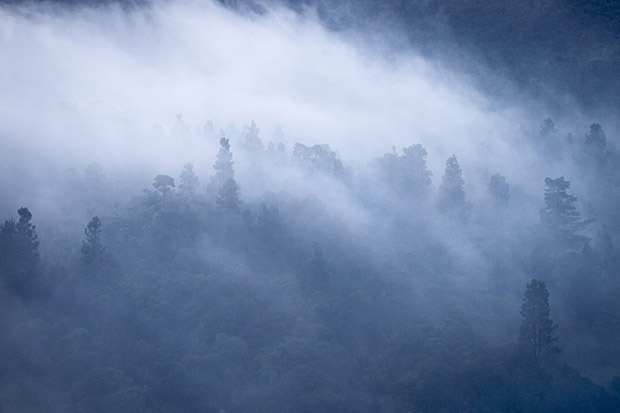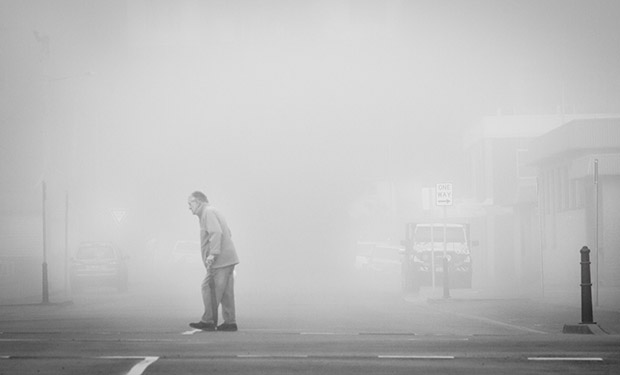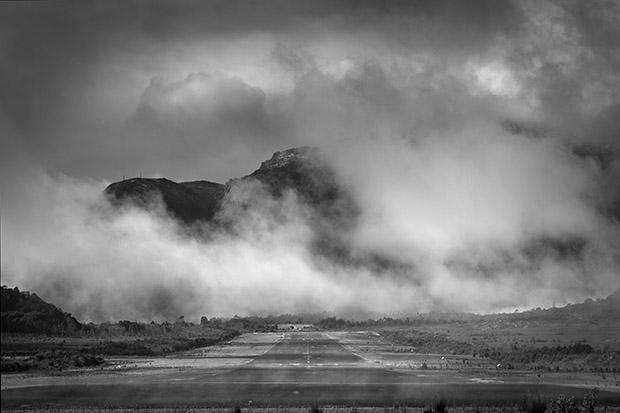It's tough getting out of bed early on cold, foggy mornings, but if shooting stunnning landscapes is your thing, it's well worth the effort. In the second of our two-part story, Thomas-Liam Ryan shares some more brilliant tips on photographing in the fog.
05 HERE COMES THE SUN
You're most likely to find fog in the early hours of the morning. This is a great time to shoot as the light is very soft. Further, as the light hits the fog it works like a massive softbox. Taking photos with the sun behind you can impart a warmth to your subject and transmit a warm glow to the fog, whilst pointing your lens into the direction of the sun can create contrasty scenes where your subject is silhouetted and the fog is backlit by the sun. This can create a striking contrast of light and dark tones.
By positioning myself on an overpass I was able to capture the fog as it moved over the highway. Canon EOS 7D, 24-105mm lens @ 32mm, 1/1600s @ f8, 100 ISO. Curves, levels, crop, mono conversion, dodge and burn in Adobe Photoshop CS5.
06 WHITE BALANCE
I like experimenting with different white balance settings when I’m photographing in foggy conditions as the impact you want to portray can be changed by simply altering the white balance setting. I prefer to shoot in RAW format, which allows me to experiment with white balance and create different versions of the same scene in post processing. Changing the white balance is just another tool in your arsenal you can experiment with to evoke different moods when you’re creating photographs in fog.
The morning I photographed this scene the conditions were bitterly cold with snow having fallen overnight. By making the white balance ‘cooler’ in post processing by shooting RAW I was able to convey this feeling of coldness. Canon EOS 7D, 70-200mm lens @ 200mm, 1/320s @ f5.6, 200 ISO. Curves, levels, white balance, dodge and burn in Adobe Photoshop CS5.
07 POST PRODUCTION
Normally in post processing I edit my images so there are level tones from black to white within the histogram. But applying this rule to photos that have fog in them, especially when the fog is the predominant feature, will remove the soft diffused qualities of the fog you’ve captured. If I need to bring out any contrast in areas I will do this selectively by using the dodge and burn tool to darken particular areas that I want to have more contrast, leaving the mystery of the fog untouched.

Rising early and shooting street scenes in the fog can create a sense of mystery. Someone crossing the street is given a different meaning when the world seems shrouded in fog. Canon EOS 7D, 70-200mm lens @ 91mm, 1/800s @ f4, 400 ISO. Curves, levels, crop, mono conversion, dodge and burn in Adobe Photoshop CS5.
08 LOOKING AFTER YOUR GEAR
When you take your camera gear from a warm house into the cold outside air, your lens can fog up. I know the aim of the game is to shoot fog, but a foggy lens won't help your cause! If I’m planning to shoot in cold and foggy conditions I leave my camera in a room that is not heated. That way the difference in temperature is less extreme when I step outside. Take a lens cleaning cloth with you and check the lens is clear before you start shooting.
Batteries run out faster in cold conditions so pack a spare. Take plenty of warm clothes, a beanie and gloves. There’s nothing worse than feeling cold and damp when you’re trying to be creative!
Sometimes when shooting in foggy conditions the atmosphere becomes so saturated it will form into a misty rain. Take a plastic bag or a dedicated camera cover to keep your camera and lens dry. A lens hood will keep most of the rain off the front element.
So, the next time foggy conditions are forecast, set your alarm clock and get out there! I guarantee you'll be rewarded with some special scenes. All you have to do then is turn those special scenes into special photos!
Because fog transforms quickly you can shoot the same landscape many times and each exposure will have its own unique look. Canon EOS 7D, 70-200mm lens @ 70mm, 1/320s @ f9, 100 ISO. Curves, levels, mono conversion, dodge and burn in Adobe Photoshop CS5.







